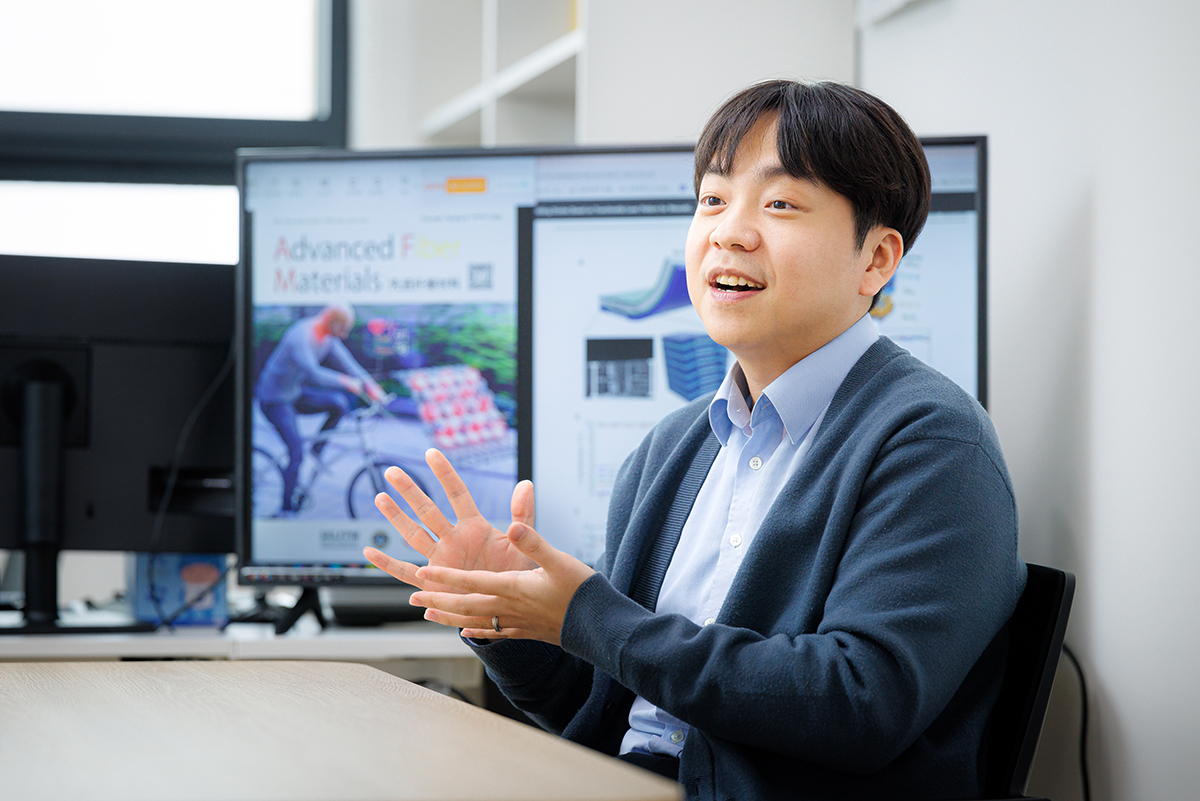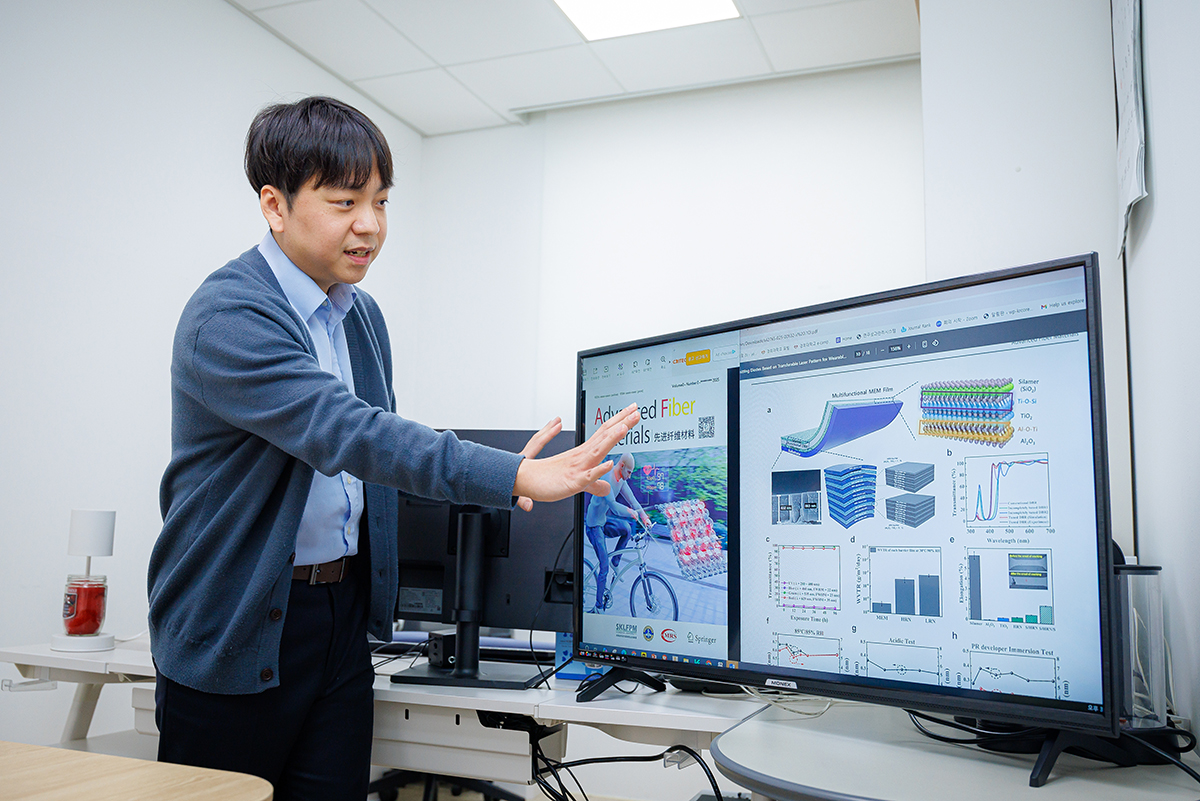News
“Wearable OLED, Reading Biometric Signals”
2025-05-14 Research

Professor Yongmin Jeon’s research team at the Department of Future Information Display has developed a stretchable OLED display that can be integrated directly into fabric. The device can be worn like regular clothing with a stretchable structure and has potential for wearable healthcare applications by optically detecting biometric signals
Professor Yongmin Jeon’s research team at the Department of Future Information Display has developed a stretchable OLED display that can be directly integrated into fabric. The device, which can be worn like clothing, features a fully stretchable structure and supports biometric signal detection. The research was published in the March 2025 issue of Advanced Fiber Materials (Impact Factor: 17.2; JCR top 1.7%), the leading journal in the field of fiber materials, under the title, “Stretchable Fabric Organic Light-Emitting Diodes Based on Transferable Laser Pattern for Wearable Photodiagnostic Applications.” The article details the integration of multiple technological components, including OLED transfer methods, structural elasticity, biometric signal acquisition, and enhanced device durability.
Applying a paper craft technique called the Kirigami pattern to ensure elasticity
Stretchable OLED is literally a “display that can stretch.” Conventional flexible OLEDs tend to lack elasticity, which makes them unsuitable for wearable applications on dynamic surfaces with frequent movements such as elbows. In particular, their operational reliability is significantly compromised when applied to rough or deformable layered substrates like textiles.
To overcome the limitations, Professor Jeon’s research team applied the Kirigami pattern, a traditional Japanese papercraft technique, to the OLED electrode structure. This design, which expands three-dimensionally when incised and unfolded, imparts structural elasticity when adapted to electronic components.
The research team formed fine incision lines on the OLED electrode based on the Kirigami structure. Using this approach, they achieved a stretchability of up to 150%. After transferring onto fabric, the electrodes operated stably while maintaining over 100% elastic deformation.
Transferring nano-elements onto fabric to implement technology without structural damage to OLED
OLEDs have a very thin and precise structure. With a thickness of nanometers (one billionth of a meter), the devices could only be produced on smooth surfaces such as glass or plastic. The research team addressed this limitation by pre-producing OLEDs on a separate substrate and then transferring them to fabric.
This method preserves the delicate structure of the OLEDs while enabling transfer onto real fabric. The challenge of this process lies in the fabric’s surface characteristics, which are generally rough and are highly curved, making reliable bonding with OLED elements difficult. To address these challenges, the team selected fibers with appropriate roughness and elasticity from various types of fibers and conducted repeated stress tests.
OLEDs are extremely sensitive to external factors such as moisture, ultraviolet rays, and physical impact. To ensure durability, the team applied a multilayer protective film (passivation) structure that provides waterproofing, UV protection, and impact resilience. Through this, they created a fiber-type OLED capable of stable long-terms operation in both indoor and outdoor environments.

Optical sensor functionality and biometric signal measurement capability confirmed by measuring photoplethysmography signals
The OLED device developed by the research team does more than emitting light; it can also function as an optical sensor measuring biometric signals when worn on the body. The team demonstrated this by measuring the photoplethysmography (PPG) signals acquired by the device while actually wearing it, analyzing light pattern reflected from the skin to assess blood flow and heart rate. Think of it as a piece of clothing that functions the same way as the latest smartwatches we wear.
The research results confirmed that the device could actually measure reliable biometric signals even when stretched up to 60%. By adjusting the intensity of the OLED light source, it was possible to compensate for signal degradation due to changes in elasticity. Real-world movement or fabric deformation did not affect the signal measurement. Professor Jeon explained, "We are entering an era where displays are no longer just screens that show information but can double up as sensors that detect health data in real time. This paves the way for smart clothing capable of health diagnosis simply by wearing it."
This study shows the potential for display technology to evolve beyond information transmission devices into sensors or treatment tools. The team is also pursuing electronic medicine applications using OLEDs, preparing clinical trials targeting skin conditions such as atopy and psoriasis. They aim to verify therapeutic effects through the light of specific wavelengths emitted by OLEDs. Professor Jeon said, “In the future, displays will communicate with the body, working as non-contact biointerfaces. This study marks a significant starting point for digital healthcare convergence technology.”
Advancing research by validating possibilities, delivering exceptional outcomes
Professor Jeon spent about three years on this research. He said, “At first, it began with a simple idea of implementing OLED on fiber, but we expanded the scope of the research to all promising areas such as biometric signal measurement, elasticity, and durability.” Throughout the research process, the team faces challenges at every stage including OLED production, pattern production, transfer, and elasticity testing. By systematically addressing one problem at a time, they progressively refined and perfected the technology.
Professor Jeon commented on his future goals and said, “As the University encourages convergence and creative research across multiple academic disciplines, I would like to continue to pursue interdisciplinary research that links electronic engineering, display technology, bioengineering, and textile engineering. Displays are evolving beyond unidirectional information broadcasters into bidirectional biosensors and therapeutic tools. We will keep expanding research that bridges people and technology, grounded in the spirit of Kyung Hee.”
-
News List
-
Kyung Hee Undergraduate Leads First Ever Global Study on the Disease Burden of Dietary Iron Deficiency
2025-05-21
More -
-
-
Highlight News
-
Info
- University Communication & Press
- +82-2-961-0106
- khsd3080@khu.ac.kr

